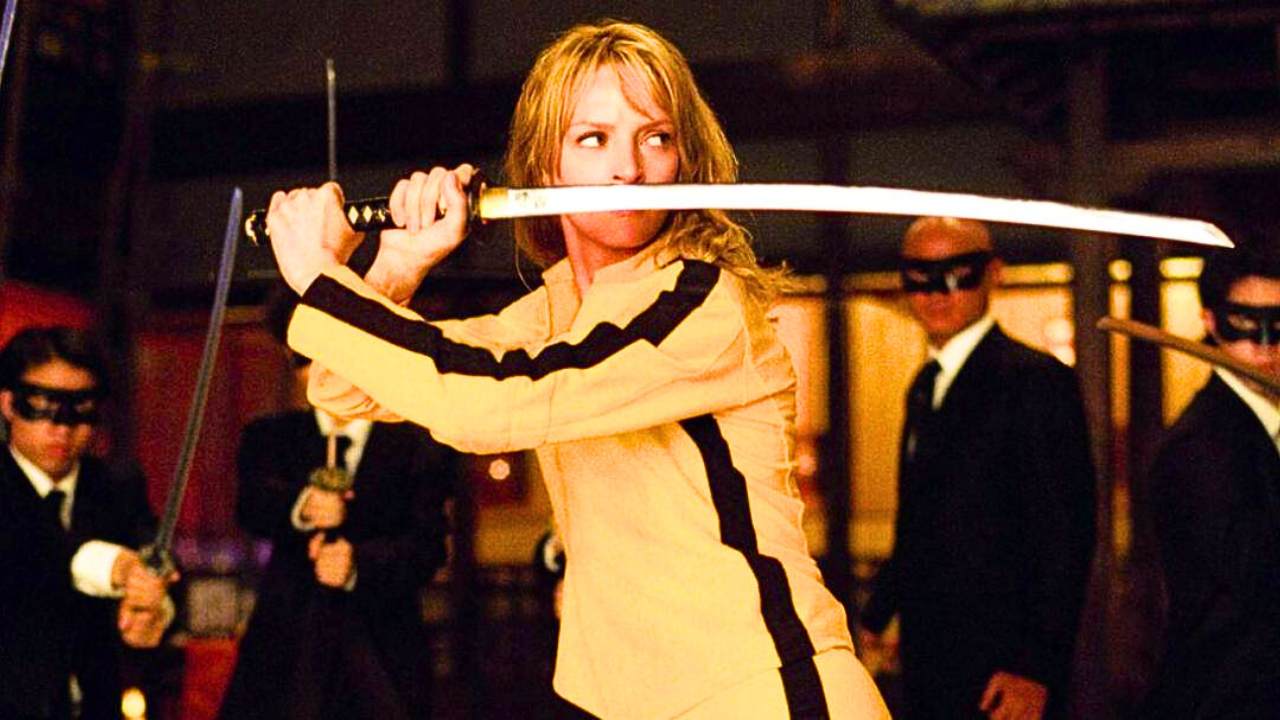Twenty years ago, Quentin Tarantino gave us “Kill Bill,” a wild ride that mashed up martial arts, cowboy vibes, and a heavy dose of revenge.

It’s 2003 and the world is a different place. “Friends” is still on the air, flip phones are all the rage, and iPods are the coolest new gadgets around. Amidst it all, a movie hits the theaters that’s unlike anything else, immediately slicing its way into pop culture fame. We’re talking about Quentin Tarantino’s “Kill Bill.”
The lights dim, the screen lights up, and bam! We’re thrust into a tale of bloody revenge led by Uma Thurman’s unforgettable character, the Bride. Decked out in a yellow tracksuit that would make Bruce Lee nod in approval, she’s a force of nature, plowing through enemies like a twister through a trailer park. Let’s not forget that haunting whistle—the theme for Elle Driver, one of the Bride’s many foes—courtesy of the brilliant composer Bernard Herrmann and reworked by Tarantino’s go-to music guy, RZA. That tune would soon echo in our heads long after we left the theater, a siren song of badassery and foreboding.
But “Kill Bill” wasn’t just a bloodbath; it was a melting pot of film genres. Tarantino took us on a globe-trotting journey, drawing inspiration from classic Hong Kong action flicks, Spaghetti Westerns, and even American blaxploitation movies. Remember the showdown at the House of Blue Leaves? That was Tarantino tipping his hat to samurai films, right down to the Bride’s Hattori Hanzo sword, a weapon so finely crafted, it could slice through both flesh and film genres with ease.
And speaking of nods to other films, that yellow tracksuit? A direct homage to Bruce Lee’s outfit in “Game of Death.” The Bride, with that get-up, wasn’t just a character; she was a living tribute to action heroes past. Through her, Tarantino was engaging in a cinematic conversation, linking his modern-day revenge tale to the classics that inspired him.
But the movie did more than just pay homage; it made its own indelible mark. Who could forget the Bride plucking out Elle Driver’s eye, or her face-off with O-Ren Ishii atop a snow-covered garden? These scenes were visceral ballets, equal parts beauty and brutality, turning violence into an art form. And let’s not even get started on the iconic “Five Point Palm Exploding Heart Technique,” a move so deadly it sounds like it’s ripped from the pages of a comic book.
The Origin—From Concept to Cult Classic
Originally, Tarantino had a single film in mind. He was a film buff with a love for the odd, the brutal, and the beautiful. He’d been itching to do a martial arts film and saw in Uma Thurman—his leading lady from “Pulp Fiction”—the perfect “Bride” for his violent vision.
But, Tarantino didn’t just wake up one day and decide to make “Kill Bill.” This was a passion project years in the making, crafted with a level of dedication that’s nothing short of awe-inspiring. Tarantino penned the role of the Bride specifically for Uma Thurman, and the duo spent years fleshing out the character and her blood-soaked quest for vengeance. They were like two artists collaborating on a violent but beautiful mural, each stroke of the brush—or, perhaps more fittingly, swing of the sword—further defining this complex character and her mission.
And let’s talk about that sword for a second, the Hattori Hanzo steel that became an extension of the Bride herself. To make sure the action scenes were not just visually spectacular but also authentic, Tarantino called in legendary fight choreographer Yuen Woo-ping. The man behind the breathtaking fight scenes in “The Matrix” and “Crouching Tiger, Hidden Dragon” had the cast undergo rigorous training. They were not just actors; they became warriors, every swing and kick practiced to near-perfection.
Tarantino also enlisted the help of other behind-the-scenes maestros. Take, for instance, Sally Menke, his long-time editor who passed away in 2010. She had the tricky task of stitching together this jigsaw puzzle of a film, with its flashbacks and abrupt tonal shifts. It’s a rollercoaster that could have easily gone off the rails, but Menke made sure every piece fit, making the movie’s narrative flow like a well-choreographed dance.
The eclectic soundtrack deserves a shout-out too. From Nancy Sinatra’s haunting “Bang Bang” to the 5,6,7,8’s garage rock, the music is another character in the movie, setting the tone and enhancing the atmosphere. It’s like the cherry on top of an already decadent sundae.
Casting was another masterstroke. Who could ever forget David Carradine as Bill, the titular villain who is as charming as he is lethal? Or Lucy Liu, whose O-Ren Ishii was a perfect blend of elegance and savagery? Each character felt like a brushstroke in a painting, distinct yet part of a cohesive whole.
The Legacy Lives On
You’ve got to admit, when a movie keeps you talking years after its credits have rolled, it’s done something right. That’s the magic of “Kill Bill.” Whether it’s the endlessly quotable lines (“It’s mercy, compassion, and forgiveness I lack. Not rationality.”), the iconic yellow jumpsuit that’s become a cosplay favorite, or the haunting whistle theme, pieces of “Kill Bill” have infiltrated pop culture in a way few films manage to do.
The Bride’s relentless journey for revenge struck a chord with viewers, sparking debates and essays about its take on feminism. Was the Bride a feminist icon, wielding her sword to cut through the literal and metaphorical patriarchs standing in her way? Or was she simply another female character subjected to violence for cinematic spectacle? These questions keep the movie fresh in the discourse, inviting new generations to dissect its layers. The film doesn’t offer easy answers, but that’s the beauty of it. It prompts discussion and makes you think long after you’ve left the theater.
And let’s not forget the impact “Kill Bill” has had on the genre itself. Before it, martial arts movies were largely a niche interest in Hollywood. Post-“Kill Bill,” we’ve seen a resurgence of films that blend action, drama, and Eastern philosophies, from “John Wick” to “Atomic Blonde.” It showed that you could have high-octane fight scenes with emotional depth, a lesson many filmmakers have since taken to heart.
Nor can we ignore the cosplay and fan art it has inspired. Just scroll through Instagram or attend any comic convention, and you’ll see the Bride, Bill, O-Ren Ishii, and the rest immortalized by fans. This artistic expression extends the life of the film, making it a cultural touchstone for communities around the world.
Tarantino has even teased the possibility of a “Kill Bill Vol. 3,” a concept that instantly sets the internet buzzing whenever it’s mentioned. Will it ever happen? That remains to be seen. But the mere fact that we’re still excited by the prospect, two decades later, is a testament to the film’s enduring impact.
More: The Quentin Tarantino Remake That Almost Was and Why Fans Will Forever Wonder What Could Have Been






